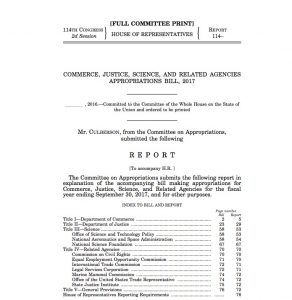May 25, 2016
Funding Season is Open: Part 3
Posted by bwebster
Thanks for staying with us as we continue to break down federal science funding for fiscal year 2017 (FY2017). To completely understand how the FY2017 landscape is evolving, I encourage you to check out the first and second parts of our funding Bridge posts.
 As you’ll recall, we previously laid out the good and bad of the Senate’s appropriations bill covering NASA, DOE’s Office of Science, NOAA, and the National Science Foundation (NSF). Today, we turn to the House’s Commerce-Justice-Science bill, which funds NASA, NOAA, and NSF.
As you’ll recall, we previously laid out the good and bad of the Senate’s appropriations bill covering NASA, DOE’s Office of Science, NOAA, and the National Science Foundation (NSF). Today, we turn to the House’s Commerce-Justice-Science bill, which funds NASA, NOAA, and NSF.
NASA, the Bad News:
- Although the House gave NASA $215 million more than in FY16, at a 1.1% increase, this is basically flat funding.
- House funding for NASA’s Earth science program was cut by 12% from FY16. This sharp decrease in funding raises concerns about constraints on NASA’s ability to pursue missions related to understanding and protecting our water supply and coastlines, among other vital goals.
NASA, the Good News:
- The House increased funding for planetary science by 13% over FY16, ensuring the continued successful development of several key decadal missions.
NOAA, the Bad News:
- The House bill decreased funding for NOAA by $185 million or 3.2% from FY16.
- The House made significant cuts to both the National Ocean Service and the Office of Oceanic and Atmospheric Research (OAR), 5% and 4% respectively, from FY16. Alarmingly, NOAA’s climate research program within OAR was cut 23% from FY16.
NOAA, the Good News
- The House gave both the JPSS and GOES-R satellites full funding at the President’s budget request level. JPSS data allows for advanced storm forecasting and GOES-R observes hazards such as hurricanes and wildfires.
NSF, the Bad News:
- The House essentially flat funded NSF from FY16.
- The House decreased the major research equipment and facilities account by $113 million or 56.44% from FY16, which could affect the agency’s ability to acquire desperately needed new ships.
NSF, the Good News:
- Unlike last year, there was no policy language in the House bill restricting NSF from providing increased funding for the Geosciences or Social, Behavioral or Economic Sciences Directorates.
- The House gave the research and related activities account, which includes the Geosciences Directorate, an additional 46%. However, that represents a mere .62% increase over FY16, which is essentially flat funding.
Comparison with the Senate CJS Bill
NASA
- Heliophysics receives an increase in funding in both the House and the Senate bills, which will help scientists to meet the challenges and reach the goals set by the Administration’s Space Weather Research Strategy and Action Plan released last fall. Both the House and Senate gave solar research increased funding; the House added $48.9 million, for a 7.5% increase and the Senate added $28.9, for a 4.45% increase.
- Following the precedent set by last year’s appropriations process, the House and Senate funding levels for Earth and planetary science demonstrate opposing prioritization of the programs by chamber, with the House favoring planetary science and the Senate favoring Earth science. These differences will have to be worked out in conference.
NOAA
- Both the Senate and the House provide full funding for service life extensions of the Next Generation Weather Radars (NEXRAD) and Automated Surface Observing Systems (ASOS). These systems increase the accuracy and timeliness of National Weather Service forecasts and warnings, particularly near airports. Despite cuts to NESDIS in both chambers, both bills provide full funding for continued procurement and acquisition of the JPSS, at $787 million, and GOES-R satellite, at $753 million.
NSF
- Both chambers essentially flat fund NSF. In order for NSF to keep up with inflation and see a real increase in spending power, it needs at least a 5% increase in funding.
- Both the House and Senate emphasize a need to fund and support research across all scientific disciplines at NSF.
- Another policy issue that arose in 2016 was the issue of science in the national interest. Both chambers seek to define the national interest in a way that addresses congressional concerns, while respecting NSF’s longstanding peer review process.
The next step is for the full House to vote on the House version of the bill and the full Senate to vote on the Senate version. During these votes, we may see amendments aimed at increasing or decreasing funding levels for certain programs or adding policy language – so-called “riders,” that could impair science.
There’s still time to weigh in with your legislator and urge them to support the Earth and space sciences. Take action today.


